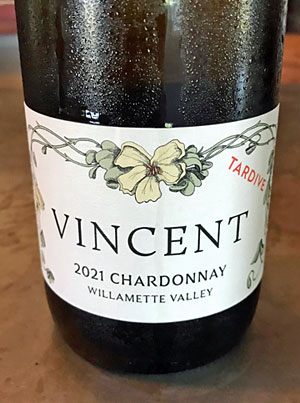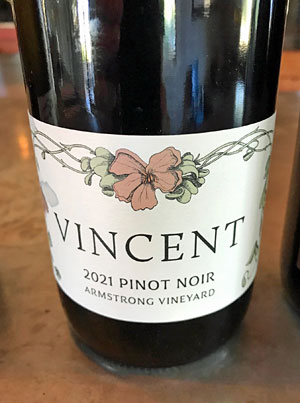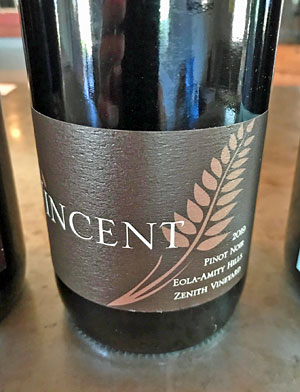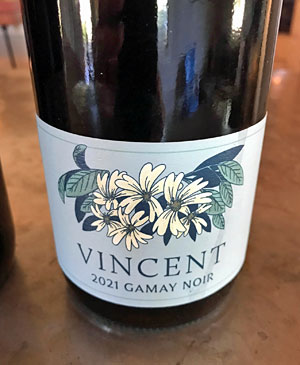Oregon Wine Visits, May 2022 – Part 3
My visit to Oregon wine country was nearing an end. Although the main point of my road trip to the Portland area was to visit my friends Jon & Ling, I’d been able to make three wine visits during my travels. It was now Monday morning, and Jon & Ling both needed to get back to their jobs and I needed to start on my way back home. I planned to have a relaxed drive, heading down the scenic Oregon Coast along the way, but I’d made one more winery appointment for that morning before making my way out to the coast. I was glad to have navigation assistance from my phone while I drove through Willamette Valley, as I might otherwise have missed some of the turns along the rural wine country roads. But with the phone’s help I had no problem getting to the winery.
 |
| Eola-Amity Hills AVA of Willamette Valley |
|
Vincent Wine Company
I pulled into the small gravel parking area of Grochau Cellars (GC Wines) in the Eola-Amity Hills AVA of Willamette Valley for my appointment with Vincent Fritzsche of Vincent Wine Company, and he came out from the tasting room there to welcome me. Vincent had arrived there just before I did, and he told me that he’d spotted my car with its California license plate along the way and figured it might be me. Although I’d never met Vincent before, we were familiar with one another through social media and I’d tried several of his wines that friends had brought to dinners or to winery lunches, and I’d been consistently impressed with them.
I followed Vincent into the modest tasting room at the GC Wines facility, where he’s been making his wines in recent years. Before he began pouring me some of his current releases to taste, he told me about his background and what led him to making wine in Willamette Valley. Vincent grew up in Southern California, and he recalled a family visit to Napa Valley when he was young and how he loved the smell of the wine cellars they visited at Christian Brothers and Inglenook. He studied English in college, and his next significant step in becoming a wine lover was when he spent a year studying in Europe around 1990 and visited Bordeaux. Vincent said that Bordeaux wines were what really got him interested in fine wine, and when he returned in California, he found that he enjoyed Napa Cabernet as well.
Not long after that, while Vincent was working in Mill Valley, he started tasting more Pinot Noirs at a nearby wine shop. He began to gravitate more toward Pinots around this time, and specifically toward Oregon Pinots. Vincent told me that he lived close to Ashbury Market in San Francisco, where Debbie Zachareas (now a partner in Ferry Plaza Wine Merchant) was the wine buyer, and she carried a number of Oregon wines that he really loved.
It was during the 1990s that Vincent began to interact with other “wine geeks” as well as winemakers on internet wine boards such as West Coast Wine Network and Wine Lover’s Discussion Group. In addition to learning more from those online discussions, he attended many offline gatherings, where he had the opportunity to try many wines he would not have otherwise had access to. Since he launched his own winery, he’s found that the connections he made online – including more recently through the Wine Berserkers forum – have been instrumental in helping to promote his wines to the many consumers who had come to know him, or at least know of him, through social media. From around 2005 to 2015, Vincent also had a wine blog called “élevage”, though he discontinued it as he needed to spend more time on his own wine business.
By the late 1990s, Vincent decided to take the next step and he did some winery work in Sonoma County in 1999. He realized that it would be possible for him to make wine himself as a custom crush client to keep costs reasonable – purchasing fruit rather than owning a vineyard, and not having to buy expensive equipment. In 2000, Vincent moved with his wife and young children to Oregon, feeling that it would be a better place to raise a family, and he took a position on the faculty of Portland State University.
In the next few years, Vincent made an effort to learn more about Willamette Valley vineyards and winemaking from local vintners. He worked the 2005 harvest season at Evesham Wood in Willamette Valley, and he also began to make wine in his garage at home at this time. He noted that his was not the typical home winemaker operation – Vincent was making commercial-quality wine in barrel quantities rather than in carboys or other small containers. In 2009 he established Vincent Wine Company, though he kept his day job – generally a wise move for a small wine producer who’s just starting out. He made the wines at a facility in Portland at first but moved to the GC Wines facility around 2015, which is also when he left his university work and made wine his full-time focus. Vincent said that he would like to have his own winery space at some point, but he doesn’t yet know how far off in the future that might be.
Vincent has mentioned that the winery name is not only because of his own name (and the name of his uncle and one of his grandfathers) but also to honor Saint Vincent, the patron saint of vintners. He’s noted that this is particularly appropriate for his winery since the Fête de la Saint Vincent is celebrated each January in Burgundy, home to Pinot Noir and Chardonnay, the wines that are the focus of Vincent Wine Company.
Vincent is currently working with about ten different vineyards. He works with organically-farmed sites, and works exclusively with non-irrigated vineyards in Willamette Valley. He showed me a large map of Willamette Valley on the tasting room wall to explain some of the key distinctions between subregions of the broader AVA that he sources most of his fruit from. Ribbon Ridge is southwest of Portland, with primarily sandy marine sediment soils, and tends to be a bit warmer and dryer due to being in the rain shadow of the coastal mountains. Farther south is the Eola-Amity Hills subregion, with mostly volcanic clay soil and a generally cooler and wetter climate from being exposed to the Van Duzer Corridor that funnels marine air in from the coast.
I asked Vincent about the distinctions that he sees in Willamette Valley Pinot Noir wines coming from vines grown in volcanic soil vs. marine sediment soil. His views are similar to those that I’d heard elsewhere, though Vincent finds the distinctions more in terms of the wines’ texture than focused on mainly flavor-based perceptions. In general terms, Vincent finds that the lower tannin of Pinot grown in volcanic soil seems to be a key in accentuating the fruit character of the wines, while the Pinot from marine soils are typically more tannic, which can give these wines darker, earthier tones and more spice.
As with most vintners, deciding on the pick date for fruit is a key for Vincent. He likes the fruit to be “al dente” – that is, not to be too ripe, not over-done, so the finished wine turns out on the lean side but not overly so. Vincent allows native primary and malolactic fermentation for all of his wines, with no adjustments to the wine chemistry and no additions. White grapes are whole-cluster pressed before going into older French oak barrels and typically aged for 12-18 months, with no lees-stirring. Vincent uses nearly all François Frères barrels for his Chardonnay and Pinot Noir. Rosé wines go through a similar process as whites though with shorter barrel-aging. The wines go through full malolactic fermentation so that no sterile filtration is necessary, and Vincent mentioned that he also likes what the malolactic fermentation adds to the texture of the white wines.
 |
 |
For red wines, Vincent chooses some fruit to be fermented with foot-trod whole clusters though he destems most of it. He told me that he uses a percentage of whole-cluster fermentation mainly for fruit grown at sites with marine sediment soils, and typically fully destems fruit from volcanic soil vineyards, as he feels that fruit already has a similar quality that it will give to the wine. Vincent feels that the whole-cluster fermentations allow more “space” in the wines, helping to open up what might otherwise be a dense sensation. Reds are fermented in 1.5-ton open-top fermenters, and they receive only limited punchdowns – Vincent mentioned that he began moving toward a lighter touch in his wines in 2011. Appellation Pinots are in barrel for about 12 months while others get around 16-18 months of aging.
Vincent started using a handful of new three-year air-dried tight-grain François Frères barrels for aging some of his 2021 Chardonnays and Pinot Noirs – only about 3-5% of the total number of barrels he uses – no new oak is used for any of his other wines. Overall the winemaking is simple and transparent, allowing the finished wines to showcase vineyard distinctions. While his winemaking would be considered by most to be within the natural camp, Vincent said that he’s not looking to be dogmatic in his methods. Something he told me that he would like to add to the winemaking at some point would be to utilize concrete tanks.
Vincent poured me tastes of five of his current release wines, starting off with the 2021 “Tardive” Willamette Valley Chardonnay. The “Tardive” bottlings that Vincent produces receive longer barrel-aging, and this Chardonnay bottling is generally aged on the lees for 18-24 months. The barrels for this wine were mostly older ones, though 20% of the wine was aged in new cooperage – Vincent said that the new oak was more for the texture than for any oak aroma / flavor. The fruit for the 2021 “Tardive” Chardonnay is mainly sourced from Dion Vineyard in the Laurelwood District of the Chehalem Mountains, with mostly own-rooted Wente 108 Clone Chardonnay vines grown in the vineyard’s silty loess soils. The wine featured aromas of lemon and green apple, fresh herbs, and lees, medium body and a lively mouthfeel, with a pleasant chalky texture on the finish.
I tasted three single-vineyard Pinot Noirs with Vincent, and the first of these was the 2021 Armstrong Vineyard Pinot Noir from Ribbon Ridge AVA. The fruit was fermented with about 25% whole clusters, and the wine was aged in barrel for 18 months. This had upfront black cherry fruit with spice, floral, and stony mineral notes in support, bright acidity and fine tannins with a slightly chalky texture on the finish. Next was the 2019 Bjornson Vineyard Pinot Noir from a higher-elevation site in the Eola-Amity Hills AVA. From Pommard and Wädenswil Pinot clones, the fruit for this wine was fully destemmed. Fairly light in color, this was less fruit-forward than the Armstrong bottling, and had earth, herb, and floral components joining the red fruit aromas, with vibrant acidity and a silky texture, and a long, lively finish.
The final Pinot was the 2019 Zenith Vineyard Pinot Noir, also from Eola-Amity Hills AVA – unlike most vineyards in that area, this one has sedimentary soil. It was one of the first vineyards that Vincent worked with when he started his own label in 2009. He used some whole-cluster fermentation for this, and aged about 25% of the wine in once-used oak with the rest in older neutral barrels. This displayed more spice, earth, and forest floor aromas along with a somewhat darker fruit profile than the first two Pinots, plus touches of flowers and stony minerals in the background, with a more structured character on the palate and moderate tannins. The three Vincent Pinots I tasted were quite distinct from one another, demonstrating how well the different vineyard sources showed through in the finished wines.
 |
 |
The last wine that Vincent poured for me was the 2021 Willamette Valley Gamay Noir, sourced from a site in the Chehalem Mountains AVA. The Gamay there was grafted onto 1980s plantings of Riesling and Gewürztraminer. About 35% of the fruit was fermented with whole clusters, though there was no carbonic fermentation. Darker and earthier in character than the Pinots, with spice and herbal notes, this was medium-bodied with a moderately tannic grip on the finish – still quite young, and some time in the cellar should benefit this one.
In addition to the wines I tasted, Vincent also makes a few appellation Pinot Noirs and a number of other single-vineyard Pinot bottlings, plus a few “Tardive” extended barrel age bottlings, other Chardonnays, both appellation and single-vineyard, as well as Rosé, Pinot Blanc, and Pinot Gris (including a skin-contact bottling). Vincent said that more of his 2021 wines have been bottled and will be released this fall. He told me that he’s been using technical corks for about three years, mostly for more consistent oxygen ingress than for TCA control, and that he’s been very happy with them. He also pointed out the new label design, which features a simpler layout with more centered text on the front labels, with the AVA now listed on back label. The current annual production of the Vincent wines is around 3,000 cases. Some departures from past Vincent wines will be coming up before too long – there will be a Tempranillo from southern Oregon, as well as a Napa Valley Cabernet Sauvignon (he worked with Steve Matthiasson on this). As Vincent had told me that some of the first wines he really loved were Cabs from Napa Valley, it seems he’s coming full circle with this wine!
I had a fantastic time talking with Vincent and tasting his wines. I don’t often come across someone like him who’s been making wine for his own label for nearly 15 years and still expresses such obvious enthusiasm and enjoyment with his work. Even though I spent close to a couple of hours with Vincent, I felt like I’d barely scratched the surface at finding out what makes him tick, which definitely makes me want to visit him again! Every single one of the five wines I tasted with Vincent was a standout for me, though if I had to pick a favorite it would be the 2019 Bjornson Vineyard Pinot Noir. But they were all so good that I suspect if I’d tasted them on another day I might well have picked a different wine as my favorite. All of the Vincent wines I tasted should be worthy of cellaring for further development. Although my sampling of Willamette Valley wines on this particular trip was quite limited due to my schedule, even with more time I think it would have been tough to top the wines from Vincent Wine Company. This was really an exceptional visit, and a great way to finish up my brief Oregon wine tour. Tasting at Vincent is by appointment only, and I’d recommend it highly.
After saying goodbye to Vincent, I was glad once more to have my phone’s navigation assistance to help me get back onto the main road toward the Oregon Coast. I spent the next 1-1/2 days driving down the beautiful coastline and stopping wherever I wanted to, enjoying the scenery along the way. On the final day of my trip I drove through the northern California coastal region for awhile before heading inland along Highway 101 and back to the Bay Area.
This was a very enjoyable trip into Oregon wine country – my first there in many years – and it helped me to learn more about vineyards and wine from several of the state’s wine regions. Although I’d known it before, my visits helped to reinforce the fact that you can’t generalize wine from Oregon, or even from just Willamette Valley.
Since the main purpose of my road trip was to see my friends in the Portland area, I knew beforehand that I wouldn’t have much time for visiting wineries or tasting rooms, and I only made it to four of them during my weeklong travels. Still, I was quite happy with my choices of Oregon wineries to visit as I thought they presented an interesting and eclectic group, all with something different to offer. Starting with a venture to revive a southern Oregon winery through new vineyard management methods at Troon, then stopping in at one of Willamette Valley’s best-known longtime Pinot producers at Ken Wright, moving on to an urban Portland winery with diverse and imaginative bottlings at Teutonic, and concluding with a relatively newer Willamette Valley vintner who’s already making top-notch wines at Vincent.
Perhaps the most important thing I learned from my visits to Oregon wineries was that it had been far too long since I’d been there, and now I see that I have so much more to discover there. I’m sure that I’ll head back there soon and hopefully will be able to spend more time checking out wineries and tasting rooms in various parts of the state. As always, thanks to everyone that I visited for being so generous with their time and their wine!
|








